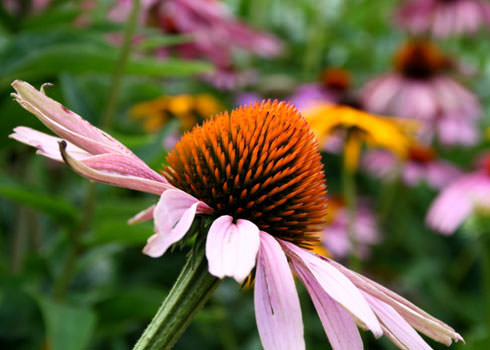

Courtesy iStockphoto/Thinkstock
Using native plants in your rain garden design will encourage wildlife and beneficial pollinators to hang out in your yard.
A thunderstorm breaks over the city, and quickly water is streaming from rooftops into gutters, sheeting across parking lots, urban driveways and sidewalks, and rushing toward sewer systems. As the racing water gathers energy, it builds the momentum to carve away the soil along streams and natural waterways while carrying a pollution load of heavy metals and other substances.
“As we urbanize, we’ve added impervious surfaces, creating more problems with flooding, putting more energy into streams, causing erosion,” explains Scott Cahail, sustainability manager for the Kansas City, Mo., Water Services Department.

Bill Hunt, PhD, PE, associate professor and extension specialist at North Carolina State University, explains that every hard surface—especially when it’s connected from rooftop to downspout to driveway to street—is damaging to rivers, ponds and lakes downstream. As an urban dweller, you can look at your own hardscape and consider opportunities to slow or divert the water before it reaches a storm drain or sewer.
Chris Obropta, PhD, PE, Rutgers Cooperative Extension environmental sciences specialist, teaches about bio-retention systems—what we call rain gardens. The stormwater gathers in these shallow landscape depressions and drains into the soil, where it’s cleaned of some of its pollution load and passed into the groundwater table, slowly reaching rivers, streams and wells. Planted with species native to their location, rain gardens become beautiful landscape features that succeed in the natural dry and wet cycles of an area while providing wildlife habitat.
“These gardens can be incorporated in almost any landscape,” Obropta explains. “We built one in the South Bronx next to a building that recycles building supplies.”
Ingrid Witty is the former president of Rockaway Valley Garden Club, which built a rain garden at Leonard Park in Boonton Township, N.J., and she appreciates the ability of a rain garden to serve as an ecosystem for wildlife.
“Because of [urban and suburban] construction, there is declining space available for native wildlife, from bees to butterflies. The more native plants you use, the more you are creating additional space for wildlife of all shapes and sizes.”
Cahail adds that rain gardens help reduce the urban heat-island effect created by impervious surfaces.
“We want to adapt how we live to repair or mitigate the impact of climate change. It’s worse in urban areas, so ideas like green roofs and rain gardens that hold more water and support natural evaporation can help us mitigate the problems we’ve created.”
Master gardener and landscape and interior designer Marcia Woods installed a small rain garden in the corner of her Winston-Salem, N.C., yard along a busy urban street.
“I wanted to install one because it’s not just a conservation issue,” she says, “it’s a water-quality issue. I can facilitate the leaching of bad materials out of the water before it hits the community water system. … People do it with a sense of what’s right for the community.”
Rain Garden Design and Installation
Watch how rainwater moves in your yard and neighborhood. Is it traveling from your roof into downspouts connected to storm drains? Are there areas in your yard where water naturally puddles? Is water sheeting down your driveway toward the street? Understanding where the water goes can help you determine a location for your rain garden.
Page 1 | 2




